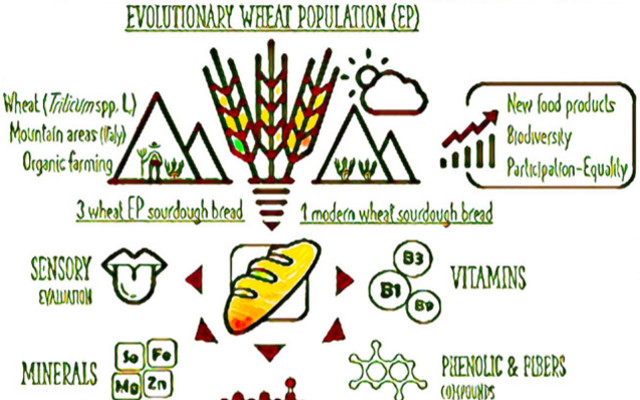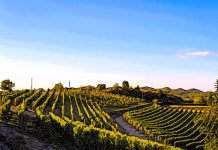The biodiversity offered by wheat varietal mixtures-as well as fostering resilience in agriculture, with respect to the current climate emergency-allows for the production of high-quality organic bread. To satisfy taste as well as nourish ecosystems and health.
This is the conclusion reached by a scientific study from the University of Parma just published in the journal Food (Spaggiari et al., 2022), ‘Evolutionary Wheat Populations in High-Quality Breadmaking as a Tool to Preserve Agri-Food Biodiversity‘. Insight.
1) Background. The wheat crisis
1.1) Climate change and the wheat crisis.
Climate change is the primary cause of the global wheat crisis gripping food security, as noted. (2) Drought in Canada and the US, low rainfall in South America, floods in France and Germany, and still dry in Russia. Skyrocketing prices.
Agriculture thus moves in two opposite directions:
– in Argentina, fazendeiros have begun growing GMO wheat designed to resist ammonium glufosinate (a reproductively toxic herbicide banned in the EU since 2018). And Jair Bolsonaro’s government has approved its distribution in Brazil, (3)
– in Sicily, eco-farmers such as Giuseppe Li Rosi, with the support of associations such as Simenza and the Rural Seeds Network, cultivate and promote the cultivation of wheat varietal mixtures(Evolutionary Wheat Populations) under organic regimes. To mitigate rather than exacerbate climate change through the negative carbon footprint of supply chains. (5)
1.2) Biodiversity at the end of its rope.
The most widespread agrifood systems on a planetary scale, in more general terms, are proving unfit to deal with the climate emergency. Biodiversity is at an end (FAO, 2019), and policies to date in Europe are not enough to recover it (6,7). Models that also contemplate the climate variable are discordant, and genetic improvement programs developed to date are ineffective. In defiance of the (false) promises of GMOs, old and new.
The situation in Italy is no different and is perhaps even worse, due to coldirette agricultural policies in the opposite direction to EU strategies
Farm to Fork
,
Biodiversity 2030
e
Soil Protection
. With the arrogance of wanting to ban seed exchange, hinder organic imports and divert NRP funds from sustainable agriculture to solar panels, logistics, mechanization.
2) Evolutionary populations and biodiversity.
2.1) Half a century of Mediterranean research.
The evolutionary populations (or varietal mixtures) of wheat, grown since 2010 in Sicily, come from the long mission to Syria-from 1980 to 2011, at the ICARDA(International Center for Agricultural Research in the Dry Areas)-of Professor Salvatore Ceccarelli and Dr. Stefania Grando, his spouse. The cultivation technique is characterized by mixing and sowing together as many genotypes of a species as possible. So as to allow the crop to adapt genetically over the years in relation to the soil and climate conditions of different areas.
Indeed, the broad genetic base of varietal mixtures allows evolutionary populations to adapt and ensure a plant presence that tends to be constant under different soil and climate conditions (Borg et al., 2018). Thus, evolutionary populations provide significant stability-even in marginal areas and extreme climatic conditions-that exceeds that of monocultures in terms of yield under the same conditions. Conversely, which, on the other hand, contribute to the progressive reduction of agricultural biodiversity. (8)
2.2) Evolutionary populations and biological system
Cereal farming is one of the sectors where the lack of biodiversity is most keenly felt. Genetic improvement has been geared toward a ‘model’ of conventional and intensive agriculture, without even considering the potential benefits of the organic system for ecosystems and human health. Nor is the marked growth in demand for organic flours (+44% in 2020 at the EU level, compared to 2019. BiolsEU source) and derived products.
Therefore, the European legislature paid specific attention to varietal mixtures in the reg. EU 2018/848. Referring specifically to evolutionary populations-in the category ofOrganic Heterogeneous Material-among the options of reproductive plant material. The European Commission, meanwhile, is advancing an action plan for the future of organic production in the EU.
3) Wheat varietal mixtures and health.
The reduction in the number of cultivated species and varieties has already been related to the endemic spread of a wide range of diseases in the human body, primarily related to the immune system and inflammation. (9) With a marked prevalence of severe and chronic diseases (NCDs, Non-Communicable Diseases), including in Italy, related to the consumption of ultra-processed HFSS(High in Fats, Sugar and Sodium) foods.
3.1) The research of the University of Parma.
The research under review (Spaggiari et al., 2022) aimed to evaluate the nutritional, chemical and sensory qualities of breads made with organic wheat flours from three different varietal blends (Bio2, Grossi, ICARDA). Compared with a bread made from flours of a commercial soft wheat cultivar. All doughs were subjected to natural leavening.
First of all, the analysis considered a number of technological parameters in raw materials and final products. In addition to nutritional values, micronutrient intakes, phenolic compounds. Detecting, in essence:
– the protein content of all grains from evolutionary populations (mean value ≈16.7 percent) significantly higher than that of commercial wheat
– the crucial role of natural leavening (with sourdough starter) for excellent processing of flours from varietal mixtures.
3.2) Excellent bread, as well as friendly to health and the environment
The sensory analysis of the different breads, conducted in Parma using the CATA(Check-All-That-Apply) method, is one of the most innovative elements of the study under review. To the rich scientific bibliography (Spisni et al., 2019) on the benefits of ancient grains for nutrition and health-and on the essential role of processing (milling, leavening, baking. See notes 10,11)-a valuable piece is added. Consumer perception of a specific food product.
Using a panel of 59 untrained consumers, the researchers developed a list of sensory attributes to describe the perception of different breads:
– texture (crust and crumb, soft and crisp),
– color (crust and crumb, pleasant and unpleasant),
– odor (pleasant and unpleasant),
– flavor (salty, sour),
– Aftertaste (pleasant and unpleasant),
– overall judgment (mediocre and excellent bread).
3.3) Sensory analysis, the results
The sensory test showed a significant difference in consumer perception on 14 of the 21 attributes among the different bread samples. And breads produced from the three evolutionary populations (EPs), or varietal mixtures of wheat, collect the excellence ratings shown in the lower right quadrant of the figure below.

Fig. 1 – Analysis of correspondences between bread samples and sensory attributes. Legend:
-BB, bread produced with EP Bio2,
-BI, bread produced with EP ICARDA,
-BG, bread produced with EP Grossi,
-BBo, bread made from conventional wheat.
4) Interim Conclusions
The valuable study recalled here highlights how evolutionary wheat populations can effectively stem biodiversity loss and counteract the effects of climate change. In a logic of food security risk prevention that should garner the attention of all players in the food supply chain.
Consumers, after all, show great appreciation for products derived from wheat mixtures, including from a sensory point of view. With the extraordinary added value of the biological system that-as well as capturing more CO2 than it emits into the atmosphere, and enriching rather than depleting soils-provides foods that nourish the microbiota and strengthen the immune system. (12)
What else?
Dario Dongo, Paolo Caruso
Cover image and Fig. 1 from study in footnote 1
Notes
(1) Marco Spaggiari, Mia Marchini, Luca Calani, Rossella Dodi, Giuseppe Di D. Pede, Margherita Dall’Asta, Francesca Scazzina, Andrea Barbieri, Laura Righetti, Silvia Folloni, Roberto Ranieri, Chiara Dall’Asta, Gianni Galaverna. (2022). Evolutionary Wheat Populations in High-Quality Breadmaking as a Tool to Preserve Agri-Food Biodiversity. Foods 11, no. 4: 495. https://doi.org/10.3390/foods11040495
(2) Dario Dongo. Skyrocketing wheat, it’s a global crisis. GIFT (Great Italian Food Trade). 10/15/21, https://www.greatitalianfoodtrade.it/mercati/grano-alle-stelle-è-crisi-globale
(3) Dario Dongo. GMO wheat from Argentina and Brazil, soon on our tables? GIFT(Great Italian Food Trade). 12.11.21, https://www.greatitalianfoodtrade.it/mercati/brasile-alle-deforestazioni-si-aggiunge-l-ecatombe-da-pesticidi-insostenibile-accordo-ue-mercosur
(4) Paolo Caruso, Dario Dongo. Wheat varietal mixtures, agrobiodiversity and resilience. GIFT (Great Italian Food Trade). 17.11.19, https://www.greatitalianfoodtrade.it/progresso/miscugli-varietali-di-frumento-agrobiodiversità-e-resilienza
(5) Paolo Caruso, Dario Dongo. Ancient grains and combating climate change, a scientific study. GIFT (Great Italian Food Trade). 4/24/19, https://www.greatitalianfoodtrade.it/progresso/grani-antichi-e-lotta-al-cambiamento-climatico-studio-scientifico
(6) Sabrina Bergamini. Biodiversity in crisis, FAO report. GIFT (Great Italian Food Trade). 6.3.19, https://www.greatitalianfoodtrade.it/mercati/biodiversità-in-crisi-rapporto-fao
(7) Dario Dongo, Marina De Nobili. CAP, pesticides and biodiversity. EU Court of Auditors report. GIFT (Great Italian Food Trade). 7/29/20, https://www.greatitalianfoodtrade.it/progresso/pac-pesticidi-e-biodiversità-relazione-della-corte-dei-conti-ue
(8) Borg J., Kiær L.P., Lecarpentier C., Goldringer I., Gauffreteau A., Saint-Jean S., Barot S., Enjalbert J. (2018). Unfolding the potential of wheat cultivar mixtures: A meta-analysis perspective and identification of knowledge gaps. Field Crops Research 221 (2018) 298-313
(9) Von Hertzen L., Hanski I., Haahtela T. (2011). Natural immunity. Biodiversity loss and inflammatory diseases are two global megatrends that might be related. EMBO Rep. 28.10.2011;12(11):1089-93. doi: 10.1038/embor.2011.195
(10) Paolo Caruso, Dario Dongo. Ancient grains vs modern grains and health, scientific review. GIFT(Great Italian Food Trade). 26.1.20, https://www.greatitalianfoodtrade.it/salute/grani-antichi-vs-grani-moderni-e-salute-rassegna-scientifica
(11) Dario Dongo, Paolo Caruso. Pasta, bread and flour, processing makes all the difference. Scientific study. GIFT (Great Italian Food Trade). 2.2.20, https://www.greatitalianfoodtrade.it/salute/pasta-pane-e-sfarinati-la-lavorazione-fa-la-differenza-studio-scientifico
(12) Dario Dongo, Andrea Adelmo Della Penna. Biological foods and the immune system, scientific evidence. GIFT (Great Italian Food Trade). 11.4.20, https://www.greatitalianfoodtrade.it/salute/alimenti-biologici-e-sistema-immunitario-evidenze-scientifiche









